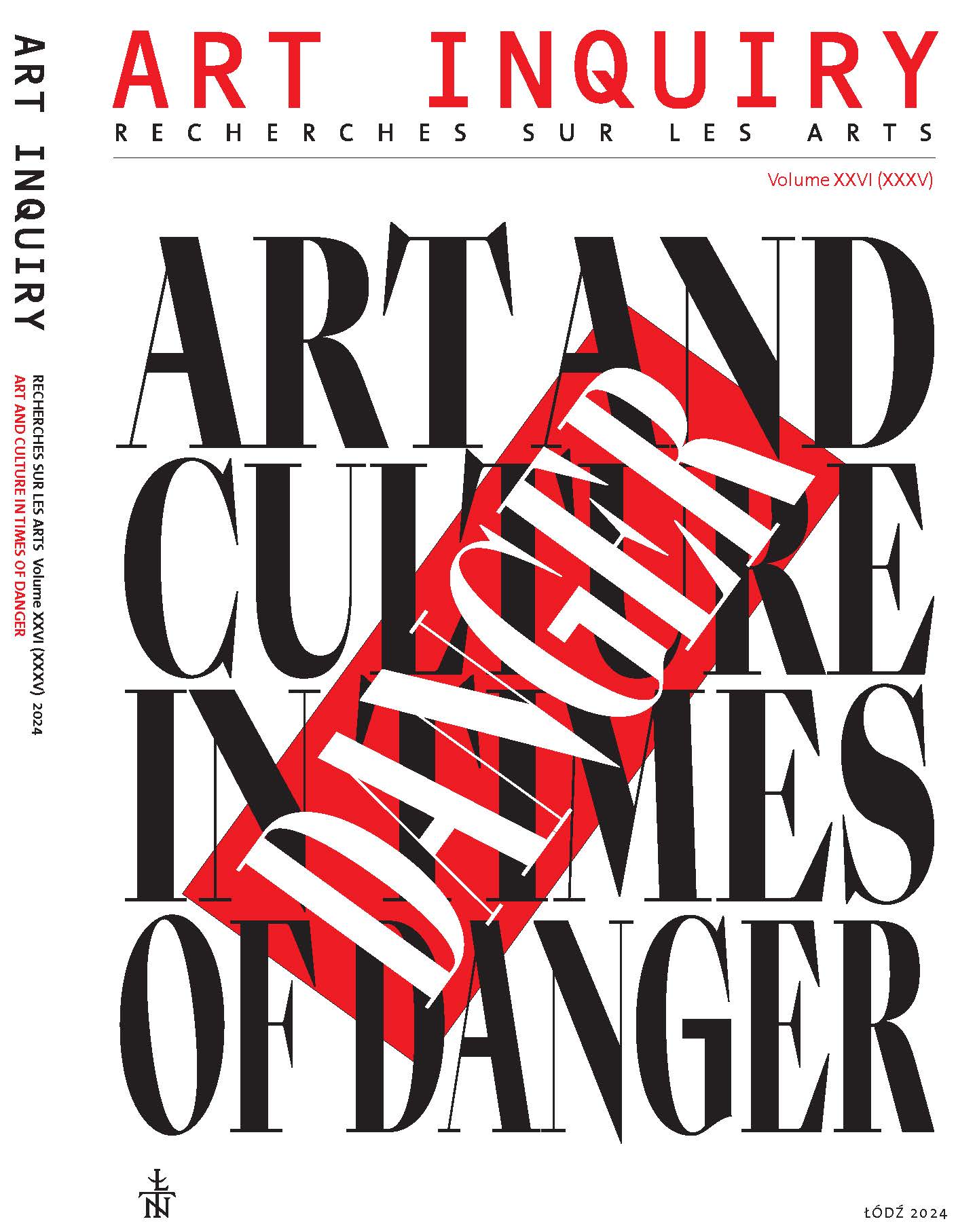Felix Nussbaum's Triumph of Death as a powerful voice of dissent against wartime
DOI:
https://doi.org/10.26485/AI/2024/26/20Keywords:
Felix Nussbaum, Jewish art, Second World War, triumph of death, HolocaustAbstract
The work of Osnabruck-born Felix Nussbaum comprises highly narrative works that show us the world seen through the eyes of a Jewish artist persecuted by a totalitarian system. The paintings, especially those with political overtones, are a peculiar diary of the Holocaust and at the same time an unusual form of showing resistance and opposition to war crimes and the dehumanisation of humankind. This article focuses on the artist's last known work, in which Nussbaum depicted the destruction of humanity in an unusually reflective and melancholic way. Currently on display as a culminating work in the labyrinthine museum space of the Felix- Nussbaum-Haus (Osnabruck), Triumph of Death (1944) should provide an important voice in the discussion about humanity: what we are capable of as humans, or how easily the foundations of civilisation are destroyed when demons triumph in our minds. It is worth leaning harder into the content of this eloquent image, especially when, once again, the end of Western civilisation seems to be at hand.
References
Ariès Phillip (2011), Człowiek i śmierć, transl. E. Bąkowska, Warszawa: Aletheia.
Battistini Matilde (2005), Alegoria i symbole. Leksykon: historia sztuki, transl. Karolina Dyjas, Warszawa: Arkady.
Bellosi Luciano (1974), Buffalmacco e il Trionfo della Morte, Einaudi, Torino: Einaudi.
Benjamin Walter (1969), Theses on the Philosophy of History, transl. Harry Zohn, New York: Schocken Books.
Berger Eva, Inge Jaehner, Peter Junk, Karl Georg Kaster, Manfred Meinz, Wandelin Zimmer (1997), Felix Nussbaum. Art Defamed, Art in Exile, Art in Resistance, Bramsche: The Overlook Press.
Bernacki Marek (2009), Próba Hermeneutycznej Interpretacji obrazu Otokara Kubina “Zatisi”, “Slavica Litteraria”, no. 12, pp. 83-93.
Białostocki Jan (1982), Symbole i obrazy w świecie sztuki, vol.1, Warszawa: Wydawnictwo Naukowe PWN, Warszawa.
Biblia to jest całe Pismo Święte Starego i Nowego Testamentu (1976), Warszawa: Brytyjskie i Zagraniczne Towarzystwo Biblijne.
Blatter Janet, Milton Sybil (1981), Art of the Holocaust, New York: Rutledge Pr.
Boel Pieter (1663), The Vanitas Allegory of the World, https://pba.lille.fr/Collections/Chefs-d-OEuvre/Peintures-XVI-sup-e-sup-XXI-sup-e-sup-siecles/Allegorie-des-vanites-du-monde/(plus).
Caillois Roger (1995), Człowiek i sacrum, transl. Ewa Burska, Agnieszka Tatarkiewicz, Warszawa: Oficyna Wydawnicza Volumen.
Engelking Barbara (1994), Zagłada i pamięć. Doświadczenia Holocaustu i jego konsekwencje opisane na podstawie relacji autobiograficznych, Warszawa: Wydawnictwo Instytutu Filozofii i Socjologii PAN.
Forstner Dorothea (1990), Świat symboliki chrześcijańskiej. Leksykon, transl. Wanda Zakrzewska, Paweł Pachciarek, Ryszard Turzyński, Warszawa: Instytut Wydawniczy Pax.
Ginczanka, Zuzanna (1942), Non omnis moriar, https://wolnelektury.pl/katalog/lektura/ginczanka-przeciw-fali-kazali-ci-plynac-non-omnis-moriar.html; https://evebigaj.com/2020/07/15/an-angel-against-her-will-zuzanna-ginczankas-non-omnis-moriar/
Huizinga Johan (1992), Jesień średniowiecza, transl. T. Brzostowski, Warszawa: Państwowy Instytut Wydawniczy.
Jedlińska Eleonora (1993), Motyw śmierci w malarstwie XIX wieku na tle obecności tego tematu w sztuce europejskiej, Łódź: doctoral thesis manuscript.
Jedlińska Eleonora (2019), Kształty pamięci, Łódź: Wydawnictwo Uniwersytetu Łódzkiego.
Junk Peter, Wandelin Zimmer (2003), Frage zeichen an jeder Straßenecke. Zwölf Briefe von Felix Nussbaum, Bramsche: Rasch.
König Eberhard (2002), Der Triumph des Todes, Der Schwarze Tod der Zeit um 1350 ored wie Kunst auf aktuellen Schrecken reagiert, “Seuchen und Plagen”, no 1.
Kuspit Donald (2011), The Spirit of Gray, in: Anselm Kiefer: The Salt of the Earth, exh. cat. Fondazione Emilio e Annabianca Vedova, June 1 – November 30, 2011, G. Celant ed., Milano 2011, reprinted in J. Słoniewski, Wątki mistyki żydowskiej w twórczości Anselma Kiefera, Warszawa 2014, https://www.academia.edu/37164229/W%C4%85tki_mistyki_%C5%BCydowskiej_w_tw%C3%B3rczo%C5%9Bci_Anselma_Kiefera_Traces_of_Jewish_Misticism_in_the_Oeuvre_of_Anselm_Kiefer_
Lurker Manfred (1989), Słownik obrazów i symboli biblijnych, transl. Kazimierz Romaniuk, Poznań: Pallotinum.
Mencfel Michał (2004), Sztuka i melancholia. O problemie pamięci w twórczości Anselma Kiefera, “Artium Quaestiones”, no. XV, pp. 181-208.
Mischke Wojciech (1990), Wizerunek własny w twórczości Bruegla Starszego, [in:] Portret. Funkcja – Forma – Symbol. Materiały Sesji Stowarzyszenia Historyków Sztuki, A. Marczak-Krupa ed., Toruń: Wydawnictwo Naukowe PWN.
Nałkowska Zofia (2011), Medaliony, Kraków: Wydawnictwo Greg.
Oosterwijk Sophie (2019), Morbid morality. The Danse macabre motif in Dutch art of the Golden Age, [in:] Mort n’espargne ne petit ne grant. Etudes Autour de la Mort et de ses Representations, I. Hans-Collas ed., Paris: Édition du Cherche-Lune, pp. 174-196.
Quignard Pascal, Nienawiść do muzyki, transl. E. Wieleżyńska, “Literatura na świecie” 2004, no. 1-2, pp. 183-200.
Scheber Jürgen, Damals im Romanischen Café. Künstler und ihre Lokale im Berlin der zwanziger Jahre, Berlin: Westermann Lernwelten GmbH.
Shallcross Barbara (2010), Rzeczy i Zagłada, Kraków: Wydawnictwo Universitas.
Stechow Wolfgang (1990), Bruegel, New York: Thames & Hudson Ltd.
Steinfeld Fritz (1984), Vergast – nicht vergessen: Erinnerungen an den Malerfreund Felix Nussbaum, Bramsche: Fromm + Rasch GmbH.
Steinkamp Maike (2017), Und noch immer tanzt der Todes. Felix Nussbaum und der Totentanz im fruhen 20. Jahrhundert, [in:] Danse Macabre. Totentanz. Katalog, Anne Sybille Schwetter ed., Osnabrück: Kerber Verlag.
Trościński Grzegorz (2013), Icones Mortis – Emblematy Georgiusa Aemiliusa i Hansa Holbeina w nieznanym polskim przekazie z XVIII wieku. Z dziejów toposu tańca śmierci w Polsce, “Bibliotekarz Podlaski”, no. 27/2013, pp. 51-103.
Voegele Jörg, Luisa Ritterhaus (2016), Danse Macabre – Totentanz – Dance of Death. 40 Jahre Graphiksammlung Mensch und Tod der Heinrich Heine, Dusseldorf: Universität Düsseldorf.
Vovelle Michel (2004), Śmierć w cywilizacji Zachodu. Od roku 1300 po współczesność, transl. T. Swoboda, M. Ochab, M. Sawiczewska-Lorkowska, D. Senczyszyn, Gdańsk: Słowo/obraz terytoria.
Walicki Michał (1947), Przed ślepcami Breughla, “Nowiny Literackie”, no. 33, p. 1, reprinted in Jan Białostocki (1956), Bruegel – pejzażysta, Poznań: Wydawnictwo Naukowe PWN.
Weiser Piotr (2012), Co raz stało się rzeczywistością, zawsze pozostanie możliwe… Śmierć według Nussbauma z przypisem do Breugla, “Teksty Drugie”, no. 1-2, pp. 255-266.
Wodecki Bernard, Eugeniusz Śliwka (1986), Religia i kultura żydowska. Materiały z sesji judaistycznej, Pieniężno: Muzeum Misyjno-Etnograficzne Seminarium Duchownego Księży Werbistów, Pieniężno.
Żuławski Mariusz (1980), Studium do autoportretu, Warszawa: Czytelnik.
Downloads
Published
Issue
Section
License
Copyright (c) 2024 Łódzkie Towarzystwo Naukowe

This work is licensed under a Creative Commons Attribution 4.0 International License.



